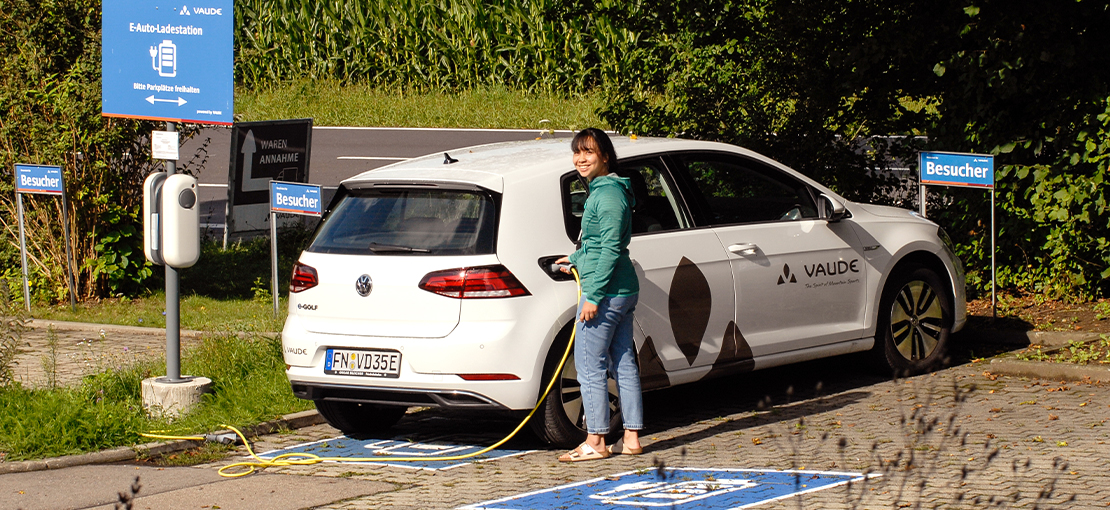
VAUDE focuses on E-Mobility
Curbing climate change and becoming independent of fossil raw materials
Employee mobility at VAUDE is already climate neutral
Since 2011, we have been recording all emissions originating from business travel, our vehicle fleet and commuting, and we pay a carbon offset to the myclimate project. More about this here
We therefore know that employee mobility is one of the largest items in our climate balance sheet every year. We have a great need for action on this issue in order to keep reducing emissions from employee mobility, for example by switching to electric vehicles.
Specifically, our goal is to reduce emissions from employee mobility 25 % by 2024 compared with 2019.
Vehicle fleet becomes E-mobile
This is why we are converting our entire fleet to electric vehicles.Since 2021, no passenger cars with combustion engines have been purchased. Our electric vehicles are charged with 100% green electricity during working hours at our company headquarters. VAUDE provides a wallbox charger to all employees authorized to use company cars for charging at home. More about the power supply at VAUDE here.
Electric cars don’t emit CO2, pollution or particulate matter while driving, unlike vehicles with combustion engines. Nevertheless, the sustainability of electric vehicles always depends on the source of the electricity that you use to charge them. They’re only more eco-friendly when you use electricity from renewable sources! Of course, this also applies to hybrid vehicles. Since these usually don’t offer much of a range while running on electricity and consume significantly more in combustion mode than pure combustion engines, they are not an option for VAUDE.
In recent years, the range of purely electrically powered cars has increased significantly; their driving range and interior space are sufficient for most needs. The lack of a nationwide charging infrastructure is still problematic. And there are extremely long delivery times – VAUDE also has to bridge these with conventional passenger cars.
It will therefore take some time before we have converted the entire fleet to e-vehicles. We will continue to drive our existing diesel vehicles until the end of the lease term and in some cases beyond. Economical driving is therefore important.
Background information and figures on mobility can be found here on the website of the German Federal Ministry for the Environment.
At the same time, we are pursuing the following goals in the restructuring of our company fleet:
- Reduction of number of vehicles
- Reduction in the number of kilometers driven
- Driver training for greater safety and lower fuel consumption
|
|
Basis Year GRI 2013 |
Basis Year Mobility Goals 2015 |
Year 2019 |
Previous Year 2020 |
Current Year 2021 |
|||||||||
|---|---|---|---|---|---|---|---|---|---|---|---|---|---|---|
|
|
|
|
absolute |
to 2013 |
to 2015 |
absolute |
to 2013 |
to 2015 |
to 2019 |
absolute |
to 2013 |
to 2015 |
to 2019 |
to 2020 |
|
Number of company vehicles (yearly average) [pc] |
65 |
75 |
60 |
-8% |
-20% |
60 |
0 |
-13% |
8% |
75 |
15%
|
0% |
25%
|
15%
|
|
Total kilometers driven by company vehicles |
2,368,262 |
2,330,397 |
1,930,104 |
-19% |
-17% |
1,930,104 |
-40% |
-39% |
-24% |
1.706.308,00 |
-28%
|
-27%
|
-9%
|
20%
|
|
fuel consumption [liters] |
170,955 |
173,061 |
129,698 |
-24% |
-25% |
129,698 |
-57% |
-57% |
-43% |
99.993,36 |
-42%
|
-42%
|
-23%
|
36%
|
|
Average consumption per vehicle per 100 km |
7,22 |
7,43 |
6,72 |
-7% |
-10% |
6,72 |
-29% |
-31% |
-25% |
5,86 |
-19%
|
-21%
|
-15%
|
14%
|
Fuel consumption VAUDE
Create your own infographicsThe Corona pandemic has also been noticeable in the fuel consumption of the VAUDE company fleet. While in 2020 fewer business trips and, above all, significantly fewer kilometers driven privately with company cars led to the lower consumption shown in the graph, fuel consumption in 2021 has risen again as a result of the return to "normality".
New system for privately used company cars
It will be interesting to see whether the federal government's coalition (the SPD, Greens and FDP) will finally set a consistent course for a transportation revolution.
Fuels in the supply chain
All facts and figures given here refer to the VAUDE company headquarters at Tettnang-Obereisenbach. With no data, we are unable at present any concrete figures for fuel consumption for our upstream supply chain.
It is clear, however, that transport and the resulting strain it places on the health of people and the environment creates global problems (for example, smog in Beijing). We are all facing the same challenges in the transportation of goods and people. Read more about our merchandise logistics.
| GRI: | 302-1 |
| GRI: | 302-2 |
| GRI: | 302-3 |
| GRI: | 302-4 |




